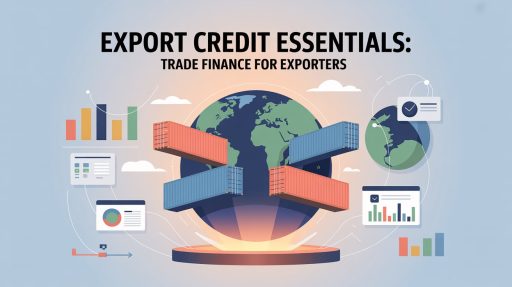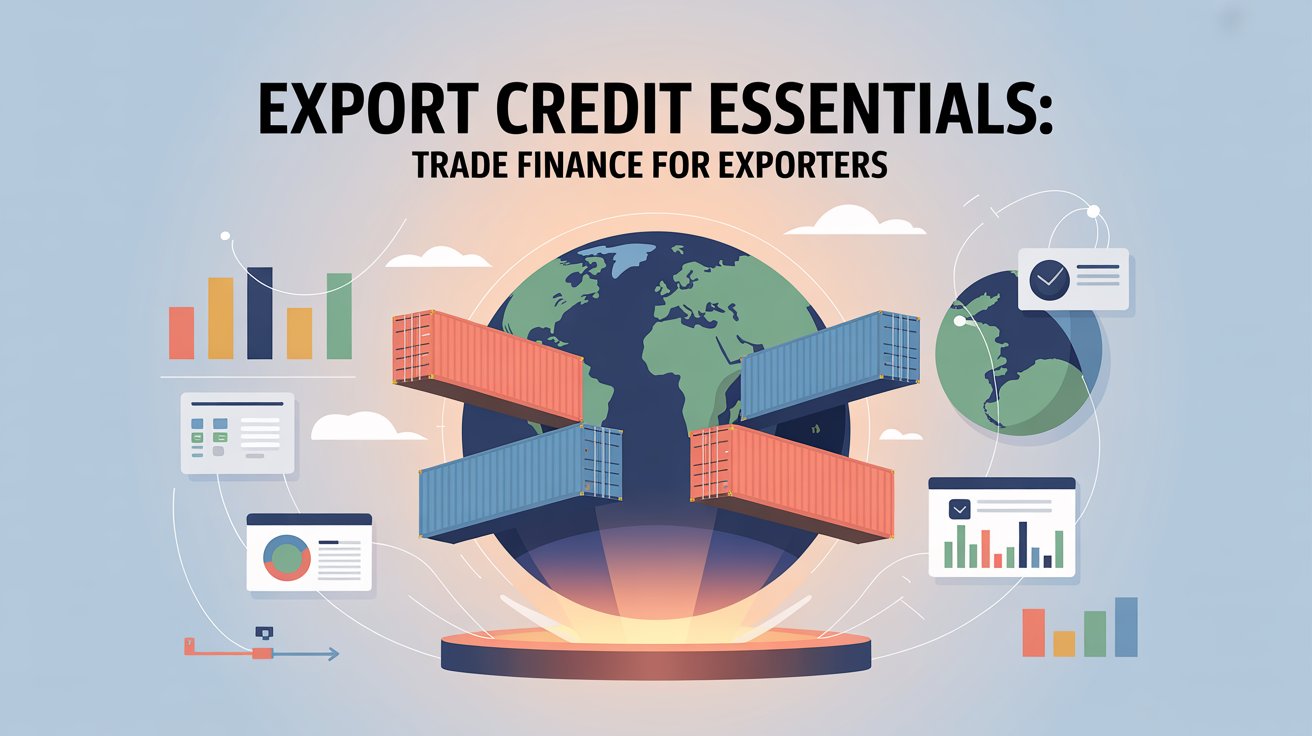Offering a road to success for a local business in the international arena, converting local businesses into international success stories. But, for those first-time exporters, unraveling the complexities surrounding export credit and trade finance might appear to be a daunting task. An understanding of these two powerful tools becomes indispensable in minimizing risks, maximizing cash flow, and fostering the growth of a sustainable global business. This guide explains how export credit and trade finance act in facilitating international trade and assist the first-time exporter in confidently tapping global opportunities.
Related Article: Find out How to Start Your Own Export Business – NPCS blogs
Understanding Export Credit: The Gateway to Global Business
Export credit is a major financial instrument allowing exporters to provide foreign buyers with competitive payment terms without endangering cash flow. It therefore acts as a bridge between selling products on foreign markets and securing the payment for them.
What is Export Credit?
Export credit includes financing facilities and insurance offered to support the exporters in extending credit to buyers abroad. Deferred payment terms are extended to make the product more attractive in the global market.
Usage of export credit enables exporters to:
- Compete with international competitors who already give flexible payment terms.
- Mitigate risks of non-payment by buyers through insurance or guarantees provided by financial institutions.
- Sell more by accommodating the financial requirements of foreign customers.
Types of Export Credit
Export credit that first-time exporters must comprehend to select the most appropriate export credit facility for any particular transaction includes the following:
- Pre-shipment Export Credit- The finance given before manufacturing or shipping of goods helps the export manage production costs.
- Post-shipment Export Credit- The financing period following shipment is initiated, while the exporter is still waiting to be paid by the buyer.
- Supplier Credit- The exporter gets the payment immediately from a bank or finance institution, who then seeks to collect the funds from the buyer.
- Buyer’s Credit- The foreign buyer secures financing to settle an invoice with the exporter; the buyer will subsequently repay the financier over an agreed timeframe.
Each of the different types of export credit serves an appropriate purpose so that during the transaction, exporters remain liquid to meet worldwide demand.
Trade Finance: Fueling International Trade Success
Export credit secures payment, whereas trade finance extends to a wider range of financial products, allowing smooth cross-border transactions. Trade finance secures healthy cash flow while mitigating risks for exporters and importers during the entire transaction cycle.
What is Trade Finance?
Trade finance encapsulates a constellation of instruments and services to facilitate international trade and commerce, standing halfway between exporters waiting for payment and importers awaiting goods to be received and sold.
Key elements of trade finance include:
- Ensuring payments between exporters and buyers.
- Mitigating nonpayment and disputes.
- Providing working capital for production and shipment.
Trade finance is the lifeblood of international trade, reassuring firms to join the international market.
Key Components of Trade Finance
So export credit and trade finance become effective in promoting internationalization only when first-time exporters understand the fundamentals:
- Letters of Credit (LCs) guarantee payment by banks to the exporter once contract conditions are fulfilled.
- Export factoring means exporters sell their receivables to other parties for immediate cash flow at a discounted price.
- Export credit insurance against the risk of foreign buyers defaulting on payment.
- These are short-term loans offered to fund the working capital needed to manufacture and deliver the shipment.
Exporters are then able to secure their transactions, increase their liquidity, and diminish business risks through the use of these trade finance options.
How Export Credit and Trade Finance Empower First-Time Exporters
For first-time exporters, export credit and trade finance serve not only as financial tools but also as growth engines for internationalization.
Here are some ways in which they help:
- Risk Mitigation: Export credit and trade finance minimize the chances of nonpayment, thus ensuring that the exporters get the payment due.
- Improved Cash Flow: Both instruments provide liquidity between the time of shipment and the time of receipt of payment, thus stabilizing working capital.
- Competitive Edge: Providing flexible payment terms using export credit will make needed exporters appealing to foreign buyers.
- Market Entry: Trade finance gives courage to the exporters to enter new markets without financial worries.
First-time exporters can use this understanding of export credit and trade finance to further their global business with minimum risk.
Download Pdf: Just For Starters: How To Start Your Own Export Business ( …
The Process of Securing Export Credit and Trade Finance
By so doing, first-time exporters are able to secure export credit and trade finance in a systematic way:
- Assess Your Needs: Look into the required amount and type of export credit or trade finance expected for your transaction.
- Select your Provider: Pick a bank, an NBFC, or an Export Credit Agency (ECA) able to offer export credit and trade finance.
- Present Documentation: Send necessary documents, namely: invoices, purchase orders, shipping documents, and the credit reports of the foreign buyers.
- Approval and Disbursement: After approval, disbursement of funds or issuance of guarantees shall take place as agreed upon.
- Repayment: Repay or settle the account through the proceeds of the export transaction.
Ensuring access to export credit and trade finance facilities smoothly through a methodical approach.
Best Practices for Using Export Credit and Trade Finance
Export credit and trade finance find their maximum utilization in a business only if they are strategically planned. Following are the best practices for the first-time exporters:
- Conduct Buyer Due Diligence: Always conduct due diligence on the creditworthiness of a foreign buyer before extending export credit.
- Understand the Terms and Conditions: Carefully read and understand all the agreements related to trade finance to prevent hidden costs or restrictive clauses.
- Do Ensure Legal Compliance: Meet all international documentation and legal standards while dealing with export credit and trade finance.
- Use Government Programs: Many governments run subsidized export credit and trade finance schemes for first-time exporters.
By following these practices, exporters can avoid common pitfalls and maximize their chances of success.
The Role of Export Credit Agencies (ECAs)
The ECAs are vital institutions for offering export credit and trade finance solutions, especially to first-time exporters venturing into risky or unknown markets. The functions of ECAs include the following:
- To provide export credit insurance and guarantees.
- To offer direct credit to foreign buyers.
- To assist exporters with competitive rates and extended repayment terms.
With ECAs, first-time exporters can hedge against political risk, commercial uncertainty, and financing constraints that come with global trade.
Future Trends in Export Credit and Trade Finance
The future of export credit and trade finance is characterized by a rapidly changing environment driven by technology, sustainability, and evolving trade practices:
- Digitalization of Trade Finance: Online platforms are making export credit and trade finance easy to get and transparent to the end-user.
- Sustainable Finance Solutions: There is rising demand for green export credit and eco-friendly trade finance.
- SME-Focused: Increasingly, institutions tailor their trade finance services to address the needs of SMEs.
Keeping on track with these trends will ensure that first-time exporters are competitive and future-ready.
Youtube Video: Start Your Own Export Oriented Unit and Most Profitable Project.
Conclusion: Expand Internationally with Export Credit and Trade Finance
For first-time exporters, mastery of export credit and trade finance is their royal road to success internationally. These vital instruments minimize risks, enhance cash flow, and create new opportunities in the market. Knowledge of export credit intricacies and trade finance mechanics will empower exporters to cultivate a strong and flourishing global business.
Whether stepping into international commercial arenas for the first time or preparing for large-scale export, the effective use of export credit and trade finance will secure your growth beyond borders.






